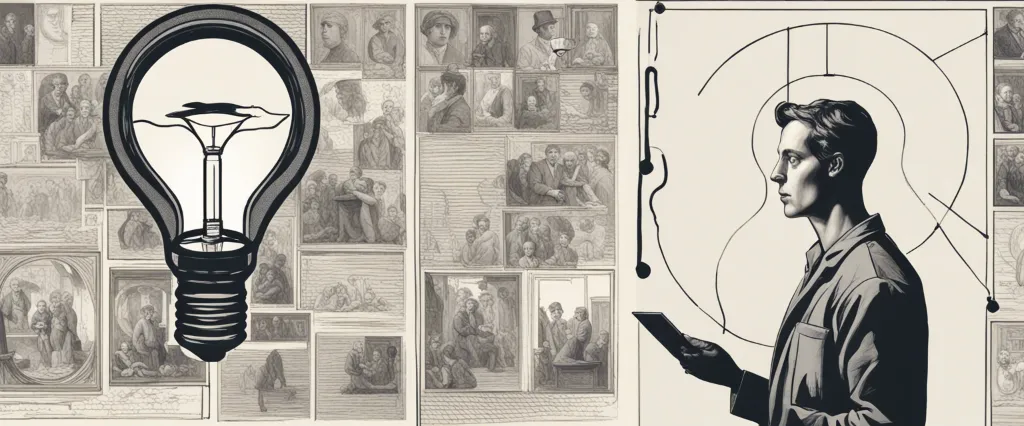
In the realm of personal growth and understanding the human mind, there exist an array of remarkable books, each offering unique insights into the complexities of our thoughts, emotions, and perceptions. Two such influential works, Byron Katie’s “Loving What Is” and Daniel Kahneman’s “Thinking Fast and Slow,” stand apart for their profound impact on countless individuals seeking radical transformation in their lives.
“Loving What Is” invites readers into the world of Byron Katie’s transformative approach, known as The Work, which centers around questioning our deeply ingrained thoughts and beliefs. On the other hand, Daniel Kahneman, a Nobel Laureate in Economics, unravels the intricacies of our decision-making process in “Thinking Fast and Slow,” providing a comprehensive exploration of the dual systems that govern our thinking.
While these two books may diverge in their approach and subject matter, they share a common thread—the pursuit of understanding human cognition and the potential it holds for personal growth. As such, this comparative study seeks to delve into the core principles and methodologies proposed by each author, exploring the similarities and differences in their frameworks, and ultimately revealing the profound ways in which they can shape our understanding of ourselves and the world we inhabit.
Through an examination of Katie’s radical approach of inquiry and Kahneman’s scientific exploration of cognitive biases, this study aims to shed light on the practical implications of their theories, as well as the potential synergy that arises from their complementary perspectives. By embracing both the power of self-inquiry and the scientific inquiry into decision-making, readers may find a comprehensive understanding of the human mind—engaging both heart and mind, intuition and reason.
Within these pages, we will embark on a compelling journey, uncovering the transformative potential of questioning our thoughts and beliefs, and understanding the hidden biases that shape our perception of reality. As we navigate the terrain of “Loving What Is” and “Thinking Fast and Slow,” we invite readers to engage with these texts not merely as separate entities, but as interactive companions in our quest for personal growth and the pursuit of a more nuanced understanding of the human mind.
Together, let us explore the pioneering ideas and wisdom captured within these pages, acknowledging the power of self-inquiry and scientific investigation, as we embark on a comparative study of “Loving What Is” by Byron Katie and “Thinking Fast and Slow” by Daniel Kahneman.
Brief Summary of Two Books
Loving What Is by Byron Katie
“Loving What Is” is a self-help book written by Byron Katie that offers a simple yet powerful tool for finding inner peace and transforming one’s life. Katie introduces readers to a method known as “The Work,” which involves questioning and challenging our thoughts and beliefs to uncover a deeper understanding of reality.
The book emphasizes the concept that our suffering is not caused by external circumstances but by our interpretation and attachment to these circumstances. Katie argues that by questioning the validity of our thoughts and beliefs, we can free ourselves from unnecessary suffering and experience greater clarity and joy.
Through real-life examples and personal stories, Katie demonstrates how “The Work” can be applied to a wide range of situations, such as relationships, career struggles, and health challenges. She guides readers through the process of identifying and questioning their thoughts, using a series of four questions and a turnaround. By examining our thoughts and considering alternative perspectives, we can cultivate compassion, patience, and understanding for ourselves and others.
Katie’s approach is rooted in the belief that reality is always kinder than our thoughts, and by embracing what is, we can find true peace and happiness. Loving What Is” serves as a practical guide for anyone seeking to question their thoughts, shift their perspective, and transcend suffering to live a more fulfilling and present life.
Thinking Fast and Slow by Daniel Kahneman
“Thinking, Fast and Slow” by Daniel Kahneman is a groundbreaking exploration of the mind’s two thinking systems: the fast, intuitive and emotional system (known as System 1) and the slow, deliberate and logical system (known as System 2). Kahneman, a Nobel laureate in economics, presents decades of research in cognitive psychology, behavioral economics, and rationality to reveal the biases and flaws in human decision-making.
The book introduces the concept of cognitive biases, which are systematic errors in judgments and decision-making that occur due to the limitations of our thinking. Kahneman explains how these biases, such as the availability heuristic or the framing effect, can lead to poor decisions and irrational behavior in various aspects of life, from personal choices to professional judgments.
Kahneman also delves into the concept of prospect theory, which challenges the classical economic assumption of rationality. He shows how our perception of gains and losses greatly influences our decisions and explains the impact of loss aversion and the endowment effect on our behavior.
Moreover, the book offers insight into the influence of intuition and heuristics on decision-making. While System 1 thinking often leads to quick judgments and intuitive decisions, it can also result in biases and errors. On the other hand, System 2 thinking, although slower and more effortful, can help us make rational choices by critically analyzing the available information.
Throughout the book, Kahneman presents numerous experiments and studies, including his collaboration with the late Amos Tversky, which investigate different aspects of human psychology and reasoning. These examples help illustrate how the mind often relies on shortcuts and simplifications, leading to predictable errors and deviations from rationality.
In summary, “Thinking, Fast and Slow” provides a comprehensive overview of human decision-making processes and the many cognitive biases that affect our judgments. It offers readers a thought-provoking examination of the mind’s strengths, limitations, and the potential for improving decision-making in various areas of life.
Comparison between Two Books

Similarities in Psychology
Loving What Is by Byron Katie and Thinking Fast and Slow by Daniel Kahneman explore various aspects of human psychology, albeit from different perspectives. Here are some similarities regarding psychology found in both books:
1. Cognitive Biases: Both books delve into the concept of cognitive biases and how they influence our thinking and decision-making processes. Kahneman extensively discusses numerous biases in Thinking Fast and Slow, while Katie touches upon them when exploring the nature of our thoughts and beliefs.
2. Subjective Perception: Both authors acknowledge that our perception of reality is subjective and influenced by our past experiences, emotions, and biases. They emphasize the importance of questioning our own assumptions and recognizing that our interpretations are not necessarily objective.
3. The Role of Emotions: Katie and Kahneman both recognize the significant impact that emotions have on our thoughts and behaviors. They emphasize the need to understand and examine the underlying emotions that drive our actions, as well as the potential biases that may emerge as a result.
4. Self-Inquiry: Both books encourage introspection and self-inquiry as a means to understand our thoughts and beliefs better. Katie’s “Four Questions” in Loving What Is and Kahneman’s exercise of examining our intuitive reactions in Thinking Fast and Slow both aim to deepen self-awareness and challenge automatic thinking patterns.
5. Mindfulness: Although approaching it from slightly different angles, both authors highlight the importance of being present and observing one’s thoughts without judgment. Katie’s “The Work” and Kahneman’s concept of System 2 thinking both require a degree of mindfulness and introspection.
6. The Illusion of Control: Both books explore the illusion of control that humans often experience. Katie challenges the idea that we can control other people’s thoughts and actions, while Kahneman highlights our tendency to overestimate our ability to predict outcomes or influence events.
7. The Power of Beliefs: Both authors acknowledge the role beliefs play in shaping our reality and perceptions. Katie emphasizes the need to question and investigate one’s beliefs, while Kahneman discusses how our beliefs and biases influence our decision-making processes.
Overall, Loving What Is and Thinking Fast and Slow provide valuable insights into human psychology, offering strategies for self-reflection, examining thought patterns, and understanding the biases that impact our thinking and behavior.
Divergences in Psychology
Loving What Is by Byron Katie and Thinking, Fast and Slow by Daniel Kahneman are two highly influential books, yet they approach psychology from different perspectives. While both books delve into human cognition and perception, they diverge in terms of their core concepts, methodologies, and ideologies.
In Loving What Is, Byron Katie introduces readers to “The Work,” a process of self-inquiry that aims to challenge and change our thoughts and beliefs about reality. She emphasizes the importance of accepting things as they are, without judgment or resistance. Katie’s book focuses on achieving mental well-being by questioning and reframing our thoughts, ultimately leading to happiness and self-acceptance.
In Thinking, Fast and Slow, Daniel Kahneman explores cognitive biases and the dual processing of the human mind. He divides thinking into two systems: System 1, which is fast, intuitive, and automatic, and System 2, which is slow, deliberate, and analytical. Kahneman exposes the fallibility of human judgment due to biased thinking and the reliance on cognitive shortcuts. He highlights the importance of being aware of these biases to make better decisions.
The divergence in psychology between these books arises from their contrasting approaches to understanding and addressing human cognition. Loving What Is takes a more subjective and experiential approach, encouraging individuals to question their thoughts and transform their perception of reality. It emphasizes the role of acceptance and personal growth in achieving psychological well-being and happiness.
On the other hand, Thinking, Fast and Slow adopts a more empirical and scientific approach, examining cognitive biases through systematic research and experiments. Kahneman presents a comprehensive investigation into the mechanisms of human decision-making and the limitations of our cognitive processes. Rather than focusing on acceptance, Kahneman highlights the importance of recognizing and overcoming biases to improve decision-making in various aspects of life.
It is worth noting that while both books address psychology and human behavior, they have different target audiences and objectives. Loving What Is primarily aims to provide individuals with tools for personal growth and inner peace. On the other hand, Thinking, Fast and Slow targets a broader audience, including psychologists, economists, and anyone interested in understanding the intricacies of human cognition.
In summary, Loving What Is by Byron Katie and Thinking, Fast and Slow by Daniel Kahneman diverge in their approaches to psychology. Katie’s book focuses on personal growth and acceptance, encouraging individuals to question their thoughts and beliefs. Kahneman’s work, on the other hand, explores cognitive biases and decision-making through an empirical and scientific lens. Despite their differences, both books offer valuable insights into the human mind and provide tools for personal development and improved decision-making.

Conclusion
Both “Loving What Is” by Byron Katie and “Thinking, Fast and Slow” by Daniel Kahneman are highly regarded books in their respective fields.
Loving What Is” is a self-help book that focuses on overcoming suffering and finding inner peace through a method called “The Work.” Byron Katie encourages readers to question their thoughts and beliefs to alleviate mental distress. This book offers a unique perspective on mindfulness and personal transformation.
On the other hand, “Thinking, Fast and Slow” is a cognitive psychology book that explores the two systems of thinking – the fast, intuitive system, and the slow, deliberate system. Daniel Kahneman, a Nobel laureate in economics, delves into decision-making biases and heuristics. This book provides valuable insights into human cognition and the ways in which our thinking can be flawed.
Both books offer different approaches and valuable lessons. If you’re looking for personal growth and strategies to overcome suffering, “Loving What Is” may be more appealing. Conversely, if you’re interested in understanding human cognition and decision-making processes, “Thinking, Fast and Slow” is better suited.
Ultimately, the choice depends on your personal interests and the specific topic you wish to explore.


